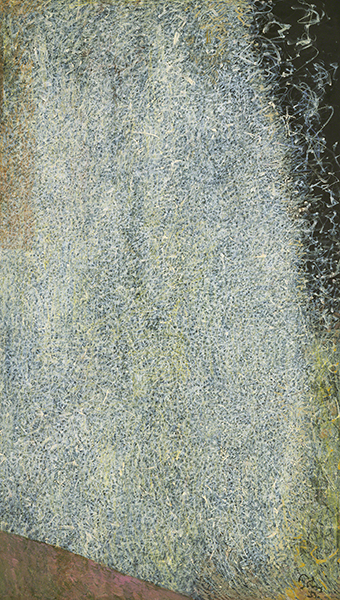An August Painting: Mark Tobey
I know we’re no longer on the “edge of August,” but this painting’s title gives me an excuse to showcase the work of one of the less-hyped New York School artists. Like many of the lesser written about associates of Abstract Expressionism, I find Mark Tobey’s work to be so multifaceted and spiritual that it sort of puts the work of Jackson Pollock (1912–1956)—whose art, don’t get me wrong, I really do love—in the shade a little bit. Ironically, in this painting, Tobey was trying to visually express the idea of being between the seasons summer and fall in nature. What was it I said last week about considering August the “end of summer”?
 |
| Mark Tobey (1890–1976, U.S.), Edge of August, 1953. Casein on composition board, 48" x 28" (122 x 71 cm). Courtesy of the Museum of Modern Art, New York. © 2023 Artists Rights Society (ARS), New York. (MOMA-P2238toars) |
By the early 1940s, Tobey's work was totally abstract, predating that of many of the Abstract Expressionists. Because many of his works referenced New York, he was often included in their shows. However, Tobey's densely packed abstract imagery of careful calculation differed from the psychic automatism of artists such as Pollock. They represent an aesthetic more impacted by higher states of consciousness than the spontaneity of uncontrolled subconscious creation.
Tobey contemplated painting the change of seasons abstractly for 10 years before he painted Edge of August. He was focused on the idea of trying to concretely express the intangible experience of being between two conditions (summer and fall). We might interpret the faint areas of green in the periphery of this composition as the last bloom of summer, but what is more fascinating is the shimmering, miniature calligraphy-like marks that enliven the picture plane. It would be a mistake to compare Tobey’s compact, abstract calligraphy to Pollock’s action painting, because Pollock was all about process, whereas Tobey’s Edge of August invites the viewer to contemplate spiritual dimensions. Tobey’s work, however, does share the Abstract Expressionist grounding in Surrealism, all-over compositions, and gestural mark making, although Tobey’s is decidedly modest.
Many American artists experimented with European-inspired abstract styles from before World War I (1914–1918) up until the time of the Great Depression (1929–1940). The postwar period and subsequent Depression fostered isolationist and nationalistic attitudes. Modernist experiment in art was rejected by the public in favor of realistic scenes of everyday American life.
On the entry of America into World War II in 1942, American artists found it was impossible to follow the traditional modes of expression then current among the Social Realists and Regionalists who dominated the art scene when the world was in shambles. Eventually, it was the war that caused the ferment that would lead to the creation of the first original American modernist movement.
American artists—seeking new forms of modern expression outside of the stale, formulaic art of artists such as Piet Mondrian (1872–1944)—were inspired by European Surrealism and the idea of subconscious and spontaneous creation. This would allow American artists to explore new forms. Despite the common belief among Abstract Expressionists about the primacy of spontaneous creation, randomness, and abstraction, Abstract Expressionism cannot be defined by a single style. For the sake of convenience, it is often divided into two main categories: action painting and color field.
The work of Tobey straddles the line between action painting and color field. He was, perhaps, one of the earliest of the Abstract Expressionists to rebel against the supposed artistic canon of Renaissance art and its emphasis on order and logical space. Born in Centerville, Wisconsin, Tobey's parents encouraged his artistic leanings. They sent him to take Saturday painting classes at the Art Institute of Chicago. This was his only official art instruction. When the family moved to Chicago in 1909, Tobey worked in fashion illustration.
In 1911, Tobey moved to New York, where he worked for McCall's Magazine and as a paid illustrator and interior designer. At the Armory Show of 1913, he was impacted by Cubism. In 1918, he accepted the Bahai faith, an event that redirected his life and guided the development of his art. It was after that conversion that Tobey rejected the tenets of Western academic art, as summed up in the canon of the Renaissance. His search for more freedom of expression and abstraction led him to Seattle in 1922, where he became acquainted with Northwest Coast Indian art and Asian art.
In Seattle, Tobey learned Chinese calligraphy and met artists and intellectuals in tune with European modernism and Eastern philosophies. A 1934 visit to Shanghai, China, cemented the marriage of Eastern and Western aesthetics in his personal art. While in China and then Japan, he studied Asian philosophy and meditation. At a Zen monastery outside of Kyoto, Japan, he studied haiku poetry. He credits these experiences with teaching him to approach his art with mental clarity.
Although he struggled to learn sumi-e (ink painting) and calligraphy—he believed he failed—Tobey developed a “calligraphic impulse” that opened new possibilities in his abstractions. By the late 1930s and 1940s, Tobey applied his numerous influences into works that reflected city themes, particularly New York. By the 1950s, his mature style had coalesced into a fusion of his influences, representations of themes that he considered universal, impacted by his spiritual and aesthetic inclinations.
Correlations to Davis programs: Explorations in Art 2E Grade 4: 6.7; Explorations in Art 2E Grade 6: 5.1; Experience Art: 6.2; The Visual Experience 4E: 4.3; Exploring Painting: Chapter 12


Comments